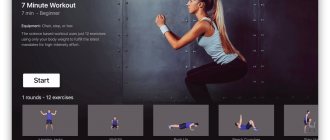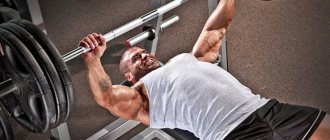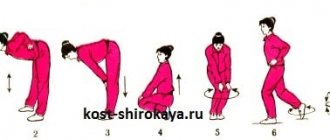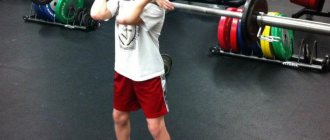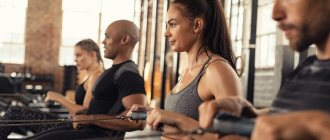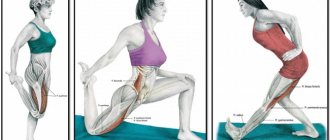The correct start and end of training is the key to its high effectiveness and minimization of injuries. If the warm-up is not neglected so often, then only a few perform the cool-down. Despite the fact that a cool-down after a workout is no less important than a quality warm-up. After strength and aerobic exercise, it is enough to perform a small set of movements, which will speed up the recovery of muscles and the body, as well as reduce the pain caused by sore throat.
The benefits of a cool-down after exercise
Cooling down plays a huge role in the proper functioning of the body and normalizes all processes. During intense physical activity, the amount of substances such as carbon dioxide, stress hormones, free radicals, etc. increases in the human body. Also, after exertion on the body, pulse and blood pressure increase. Therefore, it is necessary to bring all body processes to normal operation.
Heavy physical activity can be compared to a car rushing at high speed that needs to stop smoothly. After all, if you stop suddenly, there is a risk that you will “slam” your face into the windshield. The same thing happens to the body; it needs a smooth stop, which will normalize blood pressure, breathing and avoid overload. Cooling down brings enormous benefits to every athlete, not only in terms of health, but also in terms of emotional state, because loads without a smooth completion can disrupt the functioning of the human nervous and hormonal systems.
What is a cool-down and why is it needed?
A cool-down is a set of exercises that is aimed at high-quality completion of any workout. If a cool-down is meant to open a training session, then a cool-down is the proper way to end it. The main reason many athletes don't cool down is because they don't understand its role. If the reasons for doing a warm-up are clear to every athlete, even a beginner - it prepares the muscles and ligamentous apparatus for subsequent loads, then not everyone understands the role of a cool-down.
What is an effective cool-down:
- A short set of movements and poses, which is a transition between a fast and calm pulse (calms the cardiovascular system);
- Stretching of muscles, which promotes better lactate removal and accelerated recovery;
- Increased flexibility and release of muscles that were clogged during training.
With an understanding of what the cool-down is for and what role it plays, it becomes an integral part of the training process.
The main beneficial effects of a cool-down:
- Brings the heartbeat back to normal, makes the transition between a state of activity and calmness more correct and safe;
- Prepares muscles for subsequent loads, if necessary;
- Removing lactate, accelerating muscle recovery, relieving the effect of congestion;
- Reducing the risk of muscle spasms and cramps;
- Reduction of soreness and muscle pain during the period of muscle recovery.
Cool down exercise program
Program 1:
- Run on a treadmill in 2 sets of one minute each.
- Plank stand in 2 sets of 30 seconds with a break of 15 seconds.
- Static lunges with dumbbells for 40 seconds on each leg.
- Hanging on the horizontal bar with a reverse grip for 4 sets of 30 seconds.
- Exercise “wall engine” in 5 sets of 30 seconds.
- Exercise “cobra” in 3 sets.
Program 2:
- Exercise on an exercise bike in 3 sets of 50 seconds.
- Jumping rope in 2 sets of one minute each.
- Roll from foot to foot 15 times on each leg.
- Squats with a straight back and heels firmly pressed to the floor, 20 times.
- 5 sets of arm abductions for 30 seconds with breaks of 20 seconds.
- Bend the body towards the legs 5 times for 30 seconds with a break of 30 seconds.
Cooling down after a workout won't take long, but the benefits will be enormous. By performing a series of simple exercises, you will fill your body with positive emotions and also help it get the maximum benefit from strength training. The body will come to a state of rest, and all vital cycles will be established.
How to do it correctly
To benefit from a cool-down, you need to know how to do it correctly. To do this, you should take into account several generally accepted rules.
- Perform immediately after finishing the main part of the workout, without pausing.
- Pay special attention to those muscles that received the main load.
- Start with large muscles and end with small ones.
- The duration of fixation during stretching is about 30 seconds.
- There should be no pain - only mild discomfort is allowed.
- Alternate statics with dynamics.
- To relax the spine, hang on the bar for half a minute (2 approaches with a short rest interval).
- All transitions are smooth.
- Breathing is intense and deep.
- Total time - no more than 10 minutes.
Many coaches and professional athletes believe that the cool-down does not end after completing the last exercise (usually stretching). If you are studying at home, you need to take a warm bath, if in the hall - a contrast shower. They will complete the anti-stress effect for the muscles, body, and psyche and will help you recover faster.
All cool down goals
Cooling down after classes has the following goals:
- Prevent hyperventilation;
- Smoothly bring blood flow to normal levels;
- Reduce muscle pain after exercise;
- Normalize body temperature;
- Accelerate the removal of toxins from the body;
- Reduce rest time;
- Reduce the severity of muscle fatigue;
- Resume normal functioning of the brain, digestive tract, and genitourinary system more quickly;
- Stabilize hormonal levels.
Peculiarities!
Of course, in a healthy person, the listed indicators will gradually return to normal in any case. However, with some chronic diseases, this process can be greatly slowed down without a hitch.
What is it for?
First of all, a cool-down is necessary to normalize the functioning of the heart and blood vessels. During intense exercise, the heart rate increases and the delivery of oxygenated blood to the muscles increases. And in organs that at this moment need less replenishment (kidneys, liver, digestive tract), blood flow decreases.
During the cool-down exercises after a standard workout, the level of stress hormones in the blood gradually decreases, which leads to a slower heart rate and lower blood pressure. The vessels in the muscles narrow, and in other organs they gradually expand. This prevents the development of oxygen starvation.
Cooling down also has a beneficial effect on the respiratory system. When the intensity of physical work decreases, the need for oxygen decreases, the respiratory muscles begin to work slowly, which prevents hyperventilation.
Note!
The main symptoms of hyperventilation include dizziness, a feeling of confusion in the head, darkening of the eyes, and trembling in the limbs. If this condition appears after training, then you need to sit down, calm your breathing, and perform several breathing exercises.
Another reason not to forget about the cool-down is the need to quickly normalize muscle condition. During physical exercise, muscle fibers become shorter and thicker. This makes normal, everyday physical activity difficult. During the cool-down, the muscles gradually lengthen, returning to their original state, and lactic acid, the main source of post-workout muscle pain, is quickly removed from them.
Fast and slow recovery phases
Do you think that's all? No. The period of rapid recovery processes generally lasts 20-30 minutes. So in the time remaining after the cool-down - 10-20 minutes, you need to take a shower. This should be done not only for hygienic purposes. It speeds up recovery. In the first part of the water procedure, take a warm shower and do a foam self-massage, and finish with a contrast shower. If your gym is located next to the pool, then plan your time so that after training you can swim for 20-30 minutes at a calm pace.
How long should you rest after training in general? You need to avoid heavy physical activity for another 2 hours. This is how long the slow recovery phase lasts. However, for beginners or those who forget about the cool-down and further rest, it can last for 3-4 hours. To help restore metabolic balance, eat a snack 30-40 minutes after exercise. All you have to do is eat a banana. It can be replaced with a few spoons of corn or rice porridge with a couple of chicken medallions. If you are overweight, make sure that carbohydrates are no more than 30 g.
2 hours after finishing your workout, check your pulse. It should not exceed 75 beats/min. But before you measure it, sit quietly for a few minutes. Blood pressure should also return to normal by this time. If its values are 130 to 90 or higher, and heart rate ≥ 80, consult a trainer. The loads clearly do not correspond to your level of preparedness.
And in conclusion, recovery after physical activity is as important as the training itself. Rest properly, and then fitness will help you be beautiful and healthy.
Exercises to stretch the muscles of the legs and buttocks
Tilts down
This exercise allows you to stretch the muscles of the back of the thigh. The main thing is that when bending, your legs are completely straight. If your flexibility allows you to bend over until your chest touches your knees. Then the gluteus maximus muscle will be further stretched.
Performance:
- Stand up straight. Feet shoulder width apart.
- From this position, we lean forward and try to reach the tips of our feet with our palms. We stay in this position for 20-30 seconds.
- While bending over, you don’t need to keep your back straight as in a STRAIGHT-LEG DEADLIFT. On the contrary, we round it out by additionally stretching the gluteus maximus and lower back muscles.
Back bends while kneeling
Performing this exercise is aimed at stretching the muscles of the front of the thigh (quadriceps). For greater comfort, you can place a fitness mat under your feet.
Performance:
- Place a rug on the floor. Get on your knees.
- Place your feet hip-width apart.
- From this position, we begin to lean back as far as we can.
- To make it easier to maintain balance, place your hands on the floor. At the end point, push your pelvis forward slightly to further stretch your quadriceps.
- In this position, hold for 20-30 seconds.
Butterfly exercise
This position is very common in yoga. It is believed that it improves posture and normalizes blood circulation in the pelvis. But for us, when doing a cool-down, another fact is important. By performing the butterfly exercise, we can stretch the adductor muscles of the thigh. Ideally, you should aim for your thighs to touch the floor. Of course this will take time. Therefore, at the initial stage it is allowed to put pressure on the legs with your hands.
Performance:
- Sit on the floor. For greater comfort, you can lay out a fitness mat.
- Connect your feet together and move them as close to your groin as possible.
- Keep your back straight. Your hands can be placed on your feet, clasped, or placed on your knees.
- From this position, try to lower your hips as close to the floor as possible. If you can’t do this, then lightly press your hands on your legs.
- Stop as soon as you feel the adductor muscles stretch. And stay in this position for 20-30 seconds.
Warm-up in the hall
The gym has more options for comfortable preparation for the upcoming workout. A good place to start is with cardio equipment. You can choose a treadmill, exercise bike or elliptical according to your taste.
Perform the movement for 7-15 minutes at a medium-fast pace. This time is enough to warm up the body muscles and start metabolic processes.
Then you need to take a mat or sports mat and start warming up your whole body, starting from the top and gradually working your way down. It is important to perform movements as smoothly as possible, avoiding sudden jerks and turns. The following exercises can be included in this warm-up block:
- head turns and shoulder rotation;
- lifting and spreading arms and legs;
- rotation of the pelvis;
- tilts and turns of the head and torso;
- squats;
- lunges;
- knee lift.
Before strength exercises, it is also advisable to perform warm-up approaches without using working weight. There should be at least three such approaches, during which the weight should be added gradually. The general scheme could be like this:
- 1 approach - 30-40% of the working weight;
- 2nd approach - 50-60% of the working weight;
- 3rd approach - 70-80% of the working weight.
In each approach you need to do 20-25 repetitions.


